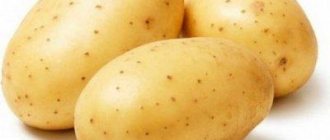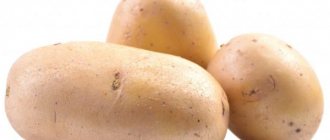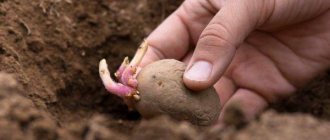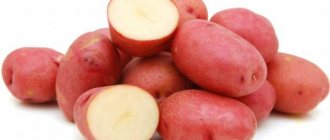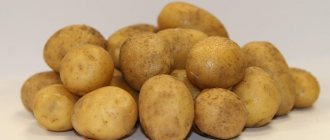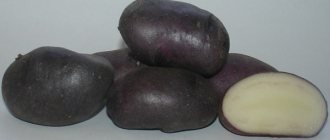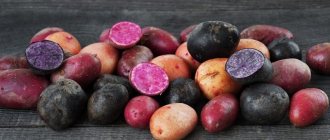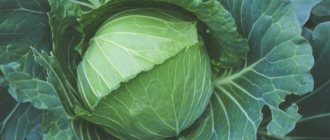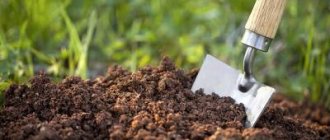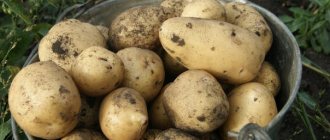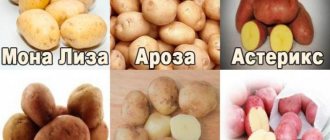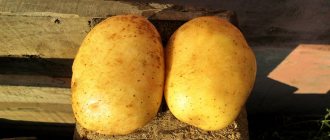Description of the variety
The bush has medium growth vigor. The buds are white. The ripening period of tubers is about 115 days. All types and varieties of Agria potatoes have rare berry production. The root crop is resistant to nematode and cancer. Culture is practically not affected by mosaics. The variety is resistant to late blight.
When considering the description of the variety, one should note its stable yield, taste, and suitability for industrial processing. The total yield with the correct growing technology is 205-320 centners per hectare. Keeping quality – about 80%. Proper care contributes to a good harvest.
Description and characteristics of the variety
In the line of promising mid-season varieties for industrial cultivation, Agria stands out. Full harvests are harvested in 110-120 days.
The plants are of medium height, the stems are located in an erect position. The flowers are white, the leaves are dark and small.
What you should know about tubers:
- average weight 120-130 g;
- skin wanting;
- the pulp is dense, creamy-yellow in color;
- the surface is smooth, with small eyes;
- oval-elongated shape;
- balanced taste;
- level of starchy substances from 8 to 16%.
The fruits are well preserved in winter. At the end of March, the yield of marketable tubers varies between 76-85%.
The taste qualities of Agria deserve a high rating of 4.5-5 points. These potatoes are rarely affected by cancer and nematodes. Weaknesses - susceptibility to late blight, scab, reduced tolerance to mosaic and curling of leaf plates.
Planting potatoes
Agria is planted at the end of March, when the danger of frost ends. The planting depth is selected taking into account the type of soil and the length of the planting material. If the soil is loose and light, then potatoes are planted to a depth of 25 cm, in heavy soil - no more than 15 cm. Large tubers are planted deeper. In dry areas, planting is deepened.
The taste of the future harvest depends on the warming of the earth - this is at least +10C. Otherwise, the potatoes will freeze and rot.
Characterization and processing of seed material is also important:
- You need to germinate potatoes within 1 month, placing the tubers in a bright room with a temperature of +13...+16 degrees.
- At the same temperature, germinate the tubers by transferring them to a container with peat.
- Germinate seed material in plastic bags.
- Dry the potatoes in the oven at +12 degrees.
Sprouted tubers need careful handling. Planting potatoes with deformed sprouts will not produce a harvest.
Advantages and disadvantages
Pros:
- adaptability to different types of soil;
- excellent product and consumer qualities;
- increased productivity;
- versatility for culinary use;
- low susceptibility to potato diseases;
- transportability;
- good preservation of tubers until spring;
- cold resistance and heat resistance.
Minuses:
- protection from pests of nightshade crops is important;
- the need for treatment against late blight and scab.
Watering
The variety is resistant to various diseases, but in order to properly grow the crop, proper watering is required. It is produced only after budding, and the soil must be kept constantly moist during this time.
Agria is watered as follows:
- The best time is evening, water consumption is no more than 2.5 liters per bush.
- After planting, do not water.
- Watering begins after the first shoots.
Soil treatment
The land is prepared for sowing in early autumn, or even better, closer to December, at the same time as fertilizers are applied. To ensure that the period from germination to harvest is minimal, Agria requires loose soil; it saturates the root system with oxygen and micronutrients.
Clay soil is used only after improvement. Lime, straw, sand, hay, and ash are added to heavy soil. In sandy soil - peat, organic fertilizers, compost.
Potato variety "Agria": description and cultivation features
The high-yielding Dutch variety of universal-purpose potatoes “Agria” is a mid-season potato variety and allows you to get a full harvest of marketable root crops in 110-120 days.
Morphological characteristics
In recent years, many domestic potato growers have begun to cultivate in large quantities the most interesting Dutch potato varieties, including Agria.
The potato bush of this variety is characterized by medium growth vigor. The corollas of the flowers are white. The period from germination to technical maturity is 110 days. Berry formation is rare.
Agria potatoes have excellent resistance to cancer and potato nematode, but are quite susceptible to late blight and common scab. The plant is slightly affected by leaf curling and mosaic.
Economic and biological characteristics
The root crops of the Agria potato are covered with a yellow, relatively dense skin with superficial eyes. The shape of the root crop is long-oval. The average weight does not exceed 137 grams. The potato pulp is yellow, with a starch content of 8.1-16.4%. The purpose of root vegetables is universal.
The value of this variety is its stable yield, excellent taste of root crops, suitability of the harvested crop for industrial processing, as well as high nematode resistance. The total yield, subject to agricultural technology, varies from 202 to 319 c/ha. Keeping quality is at least 76%, usually 85%.
Potatoes "Agria": features of the variety (video)
Potato agricultural technology
Potatoes of the “Agria” variety require a standard temperature regime of 16-22°C for growth, flowering and tuberization. Mass germination of properly prepared potato tubers begins when the soil warms up at a planting depth of 7-8 °C.
Also read: Corn: health benefits and harms
When growing Agria potatoes, the following requirements must be observed:
- preference should be given to light and medium-textured soils, chernozem, loamy, sandy, slightly alkaline or neutral soils;
- the area for planting potatoes should be as open as possible, illuminated by the sun, with a deep arable layer and high humus content;
- the soil for planting potatoes should be prepared in the fall by plowing the area with a shovel and carefully removing all the weeds;
- in the fall it is advisable to apply organic and mineral fertilizers; nitrogen-containing fertilizers are best applied in the spring, immediately when planting potatoes;
- During the season, it is necessary to carry out at least two hillings of potato bushes: the first hilling is carried out after the seedlings have reached a height of 14-15 cm, and the second time the potatoes should be hilled no later than the beginning of flowering.
It is worth remembering that seedlings appear no later than a month after planting; the average period depends on the quality of the seed, as well as climatic conditions and temperature conditions.
The greatest need of plants for water is observed during the flowering phase. During this period, tubers set. It is also necessary to water potatoes at the first signs of drying out of the soil. Then you should loosen the soil and hill up the potato bushes. Throughout the entire growing season, potato plantings must be cleared of weeds.
If there is insufficient nitrogen in the soil, potato tops develop very poorly, and the bushes grow weak, with small and sparse leaves. Lack of phosphorus causes dull and curled leaves. Elongated and pale potato leaves indicate a lack of potassium in the soil. Browning of leaves is caused by excessive watering and a lack of magnesium or zinc. Regular planting inspections allow timely identification and elimination of problems of insufficient plant nutrition.
Reviews from vegetable growers
For cultivation in private plots, it is recommended to select exclusively cancer-resistant and nematode-resistant potato varieties. The Agria variety has gained great popularity among vegetable growers not only in our country, but also abroad. It is unpretentious and demonstrates high productivity. Reviews from potato growers about this variety are only positive and characterize the Agria potato as shelf-stable, large-fruited and very tasty.
Secrets of high potato yield (video)
Potatoes of this variety have high marketability. The tubers are easy to clean, practically do not become overcooked, have a pronounced potato aroma and excellent taste. High resistance to damage by many diseases and plant parasites significantly reduces the need to use chemicals during cultivation, which makes potato tubers more valuable and useful, including suitable for baby food.
Attention, TODAY only!
Did you find an error in the text? Please select it and press Ctrl+Enter. Thank you!
Rating:
(3 ratings, average: 4.67 out of 5)
dachadecor.ru
Pest and disease control
All potato varieties, and in particular Agria, are prone to diseases and pests, the most common:
- Nematode. The larvae penetrate only ripe tubers. When harvesting, gray spots form on them. Damage occurs through infected root crops; for prevention it is necessary to control seed planting potatoes.
- Wireworms damage potatoes and stems. As a preventative measure, crop rotation with legumes is recommended.
- The mole cricket damages the seedlings, disturbing the underground part. Deep plowing is recommended as a treatment method.
- The nematode destroys the root system. Methods of control: 5-year crop rotation with planting of non-affected plants, nematode-resistant crop species.
- Scab. For prevention, scab-resistant varieties are planted.
- Cancer. When the disease appears, you must notify the quarantine inspectorate. Cancer prevention - planting resistant varieties.
Harvest and storage
The Agria potato variety is harvested for planting until the end of summer. Tubers collected at this time can be used for cooking and stored for a long time. The taste is very good throughout the winter when stored at a temperature of 4 degrees Celsius and a humidity of no more than 75%.
Storing root vegetables can cause some difficulties if the set temperature is not maintained:
- During the treatment period, seed material can be laid out in the light and greened up.
- You need to adhere to the treatment time after harvesting for up to one month, taking into account the temperature regime of 17-20°C.
- Organized ventilation system.
- Storage at a temperature of 2-3°C.
- Acceptable humidity level is 85-93%.
- Preserving the crop in nets 2 meters above ground level (best in the cellar).
Errors during storage:
- store root vegetables of poor quality (increases the chance of diseases);
- do not pick through potatoes during storage;
- store with other vegetables.
Potato agricultural technology
Potatoes of the “Agria” variety require a standard temperature regime of 16-22°C for growth, flowering and tuberization. Mass germination of properly prepared potato tubers begins when the soil warms up at a planting depth of 7-8 °C.
When growing Agria potatoes, the following requirements must be observed:
- preference should be given to light and medium-textured soils, chernozem, loamy, sandy, slightly alkaline or neutral soils;
- the area for planting potatoes should be as open as possible, illuminated by the sun, with a deep arable layer and high humus content;
- the soil for planting potatoes should be prepared in the fall by plowing the area with a shovel and carefully removing all the weeds;
- in the fall it is advisable to apply organic and mineral fertilizers; nitrogen-containing fertilizers are best applied in the spring, immediately when planting potatoes;
- During the season, it is necessary to carry out at least two hillings of potato bushes: the first hilling is carried out after the seedlings have reached a height of 14-15 cm, and the second time the potatoes should be hilled no later than the beginning of flowering.
Read also: What to do with Sasha
It is worth remembering that seedlings appear no later than a month after planting; the average period depends on the quality of the seed, as well as climatic conditions and temperature conditions.
The greatest need of plants for water is observed during the flowering phase. During this period, tubers set. It is also necessary to water potatoes at the first signs of drying out of the soil. Then you should loosen the soil and hill up the potato bushes. Throughout the entire growing season, potato plantings must be cleared of weeds.
If there is insufficient nitrogen in the soil, potato tops develop very poorly, and the bushes grow weak, with small and sparse leaves. Lack of phosphorus causes dull and curled leaves. Elongated and pale potato leaves indicate a lack of potassium in the soil. Browning of leaves is caused by excessive watering and a lack of magnesium or zinc. Regular planting inspections allow timely identification and elimination of problems of insufficient plant nutrition.
